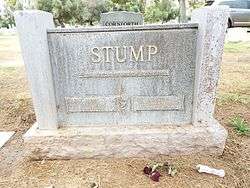Bob Stump (U.S. Congressman)
| Bob Stump | |
|---|---|
 | |
| Chairman of the House Committee on Armed Services | |
|
In office January 4, 2001 – January 3, 2003 | |
| Speaker | Dennis Hastert |
| Preceded by | Floyd Spence |
| Succeeded by | Duncan Hunter |
| Chairman of the House Committee on Veterans' Affairs | |
|
In office January 4, 1995 – January 4, 2001 | |
| Speaker |
Newt Gingrich Dennis Hastert |
| Preceded by | Sonny Montgomery |
| Succeeded by | Chris Smith |
| Member of the U.S. House of Representatives from Arizona's 3rd district | |
|
In office January 3, 1977 – January 3, 2003 | |
| Preceded by | Sam Steiger |
| Succeeded by | Ed Pastor |
| Member of the Arizona Senate | |
|
In office 1967–1976 | |
| Member of the Arizona House of Representatives | |
|
In office 1959–1967 | |
| Personal details | |
| Born |
Robert Lee Stump April 4, 1927 Phoenix, Arizona, U.S. |
| Died |
June 20, 2003 (aged 76) Phoenix, Arizona, U.S. |
| Resting place |
Greenwood Memory Lawn Cemetery (Phoenix, Arizona) |
| Political party |
Democratic (1958-1982) Republican (1982-2003) |
| Spouse(s) | Nancy Stump |
| Children | 3 |
| Alma mater | Arizona State University |
| Military service | |
| Allegiance |
|
| Service/branch |
|
| Years of service | 1943–1946 |
| Battles/wars | World War II |
Robert Lee Stump (April 4, 1927 – June 20, 2003) was a U.S. Congressman from Arizona. He served as a member from the Democratic Party from 1977 to 1983 and then later a member of the Republican Party until the end of his tenure as congressman.
Early life and career
Stump was born in Phoenix, and was a U.S. Navy World War II combat veteran, where he served on the USS Tulagi from 1943 to 1946. He graduated from Tolleson High School in 1947, and Arizona State University in 1951 where he was a member of the Delta Chi Fraternity. He owned a cotton and grain farm in the Phoenix suburb of Tolleson for many years.
He served four terms in the Arizona House of Representatives from 1959 to 1967, and five terms in the Arizona State Senate, from 1967 to 1976. He served as President of the Arizona State Senate from 1975 to 1976.
Member of Congress
He was first elected to the 95th Congress on November 2, 1976, originally as a Democrat from the 3rd Congressional District, a vast district stretching from western Phoenix through Prescott to Lake Havasu City and the Grand Canyon. However, he wore his party ties very loosely. He considered himself a "Pinto Democrat," the popular name for conservative Democrats from rural Arizona, and his voting record was strongly conservative. His profile was similar to those of conservative Democrats from the South. He voted for Ronald Reagan's tax cuts in 1981. Shortly after that vote, he announced he would become a Republican when Congress reconvened in January 1982. Regardless of his party affiliation, he never faced serious competition at the ballot box. He briefly considered running for the Senate in 1986 after Barry Goldwater decided to retire.[1]
Described as "quiet" and "assiduously private",[1] Stump kept a fairly low profile for most of his tenure. He had only a skeleton staff; he was known to answer the phone himself at his Washington, D.C. office, and to open his own mail.[1][2][3] Stump usually returned home to work his farm in Tolleson on weekends.
In his 26 years in the House he became a noted member of the House Armed Services Committee, serving as chairman from 2001 to 2003. He'd chaired the House Veterans' Affairs Committee from 1995 to 2001, when he was forced to give that post up due to caucus-imposed term limits. He is one of the few members of the House to chair both committees.[4] He consistently supported increased spending on the military and veterans.[2][3][5] The 2003 military appropriations authorization act was named after him in recognition of his commitment to the military as the Bob Stump National Defense Authorization Act for Fiscal Year 2003.[6]
Stump sponsored bills to make English the official language for government business and to alter laws so that children born to non-citizen parents would not be citizens.[3] According to Amy Silverson, he was "best known in Congress as a perpetual naysayer, casting votes against almost all spending programs."[1]
Between 1976 and 2002 he accumulated a lifetime score of 97 (out of 100) from the American Conservative Union.[7] He received very low scores from the National Council of Senior Citizens, the American Civil Liberties Union, the AFL-CIO, the NAACP, and the League of Conservation Voters.[8]
Although his district included the entire northwestern portion of Arizona, the great majority of its residents lived in the West Valley. Stump was often accused of addressing himself mainly to the West Valley and ignoring the other portions of his sprawling district, even though the district's center of gravity had moved to the West Valley as early as the 1970s. Indeed, many of his constituents rarely saw him. He maintained his district office in downtown Phoenix, outside his own district, for many years.[1]
Bob Hope announcement
After the Associated Press mistakenly placed Bob Hope's obituary on its web site in June 1998, Stump announced on the floor of the House that the entertainer had died.[9][10] This was quickly denied by his daughter and publicist; Hope died in 2003, at the age of 100.
Death and legacy

He decided not to run for re-election in 2002 due to declining health. He endorsed his longtime chief of staff, Lisa Jackson Atkins, as his successor in what was then numbered as the 2nd District. Atkins had been very visible in the district, to the point that many thought she actually represented it rather than Stump. However, Atkins was defeated in a seven way Republican primary by Trent Franks, who still holds the seat. Stump died June 20, 2003 of myelodysplasia, a blood disorder and was buried at Greenwood/Memory Lawn Mortuary & Cemetery in Phoenix with full military honors.[1][2][5]
In 2004 the Department of Veterans Affairs Medical Center in Prescott, Arizona, was renamed the Bob Stump Department of Veterans Affairs Medical Center. Stump is no relation to the member of the Arizona Corporation Commission of the same name. In 2006 SR 303L was renamed the Bob Stump Memorial Highway.[11]
References
- 1 2 3 4 5 6 Silverman, Amy (1993-10-13), "The Stealth Congressman", Phoenix New Times, Phoenix New Times, retrieved 2009-08-26
- 1 2 3 "Former Ariz. congressman Bob Stump dies", USA Today, USA Today, 2003-06-22, retrieved 2010-03-05
- 1 2 3 "Rep. Bob Stump of Arizona retiring", USA Today, USA Today, 2002-04-26, retrieved 2010-03-05
- ↑ AZ HCR 2043
- 1 2 "Bob Stump, 76, Ex-Congressman of Arizona", The New York Times, The New York Times, 2003-06-24, retrieved 2010-03-05
- ↑ Public Law 107–314—Dec. 2, 2002
- ↑ ACU House Ratings 2002.
- ↑ Green, Justin (1996-10-28), "Claims Stump doesn't represent most of constituents", The Daily Courier, Google News, retrieved 2010-03-05
- ↑ House Proceeding, June 5, 1998 (6:01:45 from start). From C-SPAN.
- ↑ "Premature report of Bob Hope's demise". BBC News. 1998-06-06.
- ↑ http://www.azdot.gov/Highways/Valley_Freeways/Loop_303/North/PDF/SR303L_DESIGN_CONCEPT_REPORT_Appendices.pdf
External links
- United States Congress. "Bob Stump (id: S001044)". Biographical Directory of the United States Congress.
- Appearances on C-SPAN
- "Bob Stump, 76, Ex-Congressman of Arizona, Dies". The New York Times. June 24, 2003.
- Robert Lee "Bob" Stump at Find a Grave
| U.S. House of Representatives | ||
|---|---|---|
| Preceded by Sam Steiger |
Member of the U.S. House of Representatives from Arizona's 3rd congressional district 1977–2003 |
Succeeded by Trent Franks |
| Political offices | ||
| Preceded by Sonny Montgomery Mississippi |
Chairman of the House Veterans' Affairs Committee 1995–2001 |
Succeeded by Chris Smith New Jersey |
| Preceded by Floyd Spence South Carolina |
Chairman of the House Armed Services Committee 2001–2003 |
Succeeded by Duncan Hunter California |
